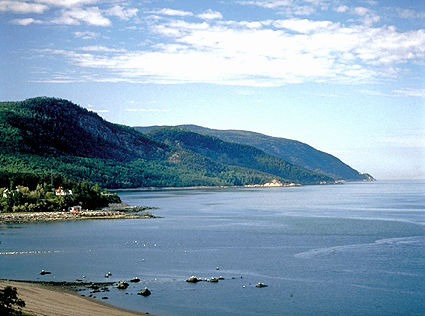
Regionalism refers to the distinctive local character of a geographic area, or to a people's perception of and identification with such places. In Canada, regional identities were formed after Europeans settled across the continent among distinct First Nations tribes. Today, regionalism is expressed in various provincial identities, in our economy, and in the daily textures of life in different parts of the land.
First Nations and Early Settlers
The phrase "Canadian regionalism" refers broadly to the vitality of regional differences within Canada. But it also refers to tensions between national and local economic, institutional and emotional attachments.
Regionalism is an inescapable part of society, economy and politics in Canada. That’s hardly surprising, considering that a national state was imposed, 150 years ago, over a vast territory and over scattered different peoples.
Before European arrival, the land of Canada was occupied by many distinct First Nations tribes. When Europeans began arriving in the early 1600s, they settled first on the East coast and then moved west, restricted in the north by the tundra and in the south by American expansion.
Some European settlers arrived early in the 17th century when a few fishermen were left behind in rockbound Newfoundland harbours. At the same time, Acadian settlers occupied the marshlands of the Bay of Fundy, and French settlers began to farm the narrow borders of arable land along the St. Lawrence River. Much later, Irish, Scots and English — propelled by Highland clearances, Irish famine or the technological and demographic changes of early 19th-century industrialization — filled up the southern Ontario peninsula and the fishing harbours, the lumber camps and the agricultural patches of Atlantic Canada (see Immigration).
The descendants of all these settlers soon faced a common predicament. The patches of settlement were small, their agricultural possibilities limited, and as numbers multiplied in these rural pre-industrial societies, there was soon a shortage of land. The pioneer fringe ran into rock. Until the end of the 19th century, there was no western safety valve, only the granitic Canadian Shield and other already settled patches of British America.

Settling the West
The surplus young faced the choice of striking north into rock and spruce or south into the United States. Only when the Canadian Pacific Railway reached Winnipeg in 1881 did Canada really acquire a West.
The Canadian Prairie was settled over a short generation before the First World War, by migrants from eastern Canada, emigrants directly from the British Isles, and by the late 19th- and early 20th-century peasant migration to America from central Europe. A wave of American settlement moving northward along the eastern flank of the Rockies added to the European population. In British Columbia, settlers tended to come from Ontario, Atlantic Canada or Asia.
There was no continuous, expansive Canadian experience with the land. One patch would fill up, then people would emigrate to a new area. Different patches were settled at different times by people of different backgrounds who depended on different technologies and economies. The country's underlying population structure was disjointed and discontinuous.

Central Canada and the Rest
The Canadian economy also fuelled regionalism. The decision to create a Canadian market was implicit in Confederation and explicit in the National Policy that followed it. Protected by tariffs against US products, manufacturing flourished in the St Lawrence-Great Lakes lowland (southern Ontario and southern Québec), where most of the Canadian market was located and from where there was good access to the hinterlands in the east and west.
The rest of the country would consume the products made in the core, and would supply it with raw materials in return. Canadian settlements achieved a considerable economic integration. Most secondary industry and financial institutions were concentrated in Montréal or around the western end of Lake Ontario. Resource-based primary industries were scattered across the land, and core and periphery were linked by growing commercial and financial networks.
Economically, such integration encouraged sharp regional specialization, reflected, for example, in the Prairie wheat economy. Emotionally, it laid the basis for strikingly different regional perceptions of Canada. Those at the core tended to feel expansive about the country on which their economy relied and over which their institutions exerted much influence. French Canadians, who worked in the factories but did not own them, had little entrepreneurial enthusiasm for a transcontinental country and a good deal of cultural suspicion of it. But for most English speakers in the core, a British Canada that stretched from sea to sea would reinforce their traditions as it expanded their markets.
On the other hand, those on the peripheries were suspicious of the core. Many saw that their local circumstances were controlled from the core, and felt they were subsidizing central Canada and absorbing the cost of Confederation. What was seen as a National Policy in central Canada, was interpreted by the Maritimes as Upper Canadian imperialism, and in the West as economic manipulation. From a Prairie or Maritime vantage point, the "Big Interests" and "Special Privileges" lived in central Canada.
Provincial Identities
Regional identities are strikingly notable among provinces, and also within provinces (for example, the distinctiveness of Cape Breton in Nova Scotia). The provinces — each with its own clear boundaries and constitutionally defined power — now tend to replace local settlements, and also broader amorphous regions, as a means by which Canadians express their regional identity.
Regional sentiment in the provinces arose while governments were assuming a larger role in Canadian life. Provincial governments have played a growing role in the national economy, and the provinces a growing role in Canadian feeling.
Many activities once organized at different regional levels are now organized provincially. At the same time, federal power has increased as Ottawa has expanded its services and its economic presence. One result of the growth of provincial and federal governments is an increasingly polarized debate between national and more regional conceptions of Canada.
Québec
Regionalism among provincial governments is probably most obvious in Québec. The culture of a French-speaking, Roman Catholic people was once defended by the local community, by a variety of nationalistic societies, and above all by the Roman Catholic Church. For some, the clearest defence of francophone culture was a rural life and a high birthrate, and from this perspective the provincial government could do little more than encourage colonization.
In recent times, however, government has assumed the defence of culture. Many French-speaking Québecois have concentrated on increasing the political power of the Québec government. The protection of the French language, a central element of the regional variety of Canada, has become a political issue dependent on different conceptions of federal and provincial responsibility.

Natural Resources
The economy is an even more pervasive source of federal-provincial conflict. The location of oil and coal fields, and other economic resources, have challenged economic assumptions held by Canadians for 100 years.
Federal political power resides in the core, and if the Constitution leaves ample opportunity for federal influence on resource policy, then the economic advantages of the peripheries can be compromised by the protective instincts of the core, which accounts for the aggressiveness of western provinces and Newfoundland over resource control.

Other Expressions of Regionalism
Canadian regionalism is now most vigorously promoted by provincial politicians and is most stridently expressed in federal-provincial debate, but underneath this rhetoric lies the far more subtle regional texture of Canadian life. It is expressed in the distinctive landscapes of farm, village and city, across the breadth of Canada. It is expressed in different accents and different memories of different pasts. It is expressed in the ways of life associated with different resource-based economies in different physical settings. It is expressed in the relationships of towns to different hinterlands and to different positions in the urban system. And it is expressed most sensitively throughout Canadian painting and literature.

 Share on Facebook
Share on Facebook Share on X
Share on X Share by Email
Share by Email Share on Google Classroom
Share on Google Classroom


